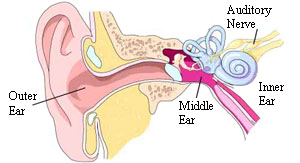With any child who is deafblind, it’s important to understand the mechanics of hearing loss so that effective educational strategies can be developed.
Hearing is the detection of sound. Sound waves travel into the outer ear, are amplified in the middle ear, and then are converted into neural impulses in the inner ear.

There are four types of hearing problems:
- Conductive loss
- Sensorineural loss
- Mixed loss
- Processing disorders
There are four degrees of hearing loss:
- Normal
- Slight
- Mild
- Moderate
- Moderately severe
- Severe
- Profound
Hearing professionals include:
- Otolaryngologist or ear, nose, and throat doctor/ENT
- Audiologist (clinical and educational)
- Hearing aid dealer
- Teachers of the deaf/hard of hearing
There are two basic hearing tests:
- Pure tone audiometry
- Speech audiometry

There are several special hearing tests:
- Otoacoustic Emissions Audiometry or OAE
- Behavioral Observation Audiometry or BOA
- Visual Reinforcement Audiometry or VRA
- Play Audiometry
- Auditory Brainstem Response or ABR
- Immittance Testing is a middle ear test that determines if there are middle ear problems
- Tympanometry tests middle ear functioning and measuring the flexibility of the eardrum
